The GitHub Copilot Coding Agent changes how .NET developers get work done. Beyond inline suggestions, it can analyze your repo, plan multi‑step tasks, create issues and pull requests, and carry changes across projects—all in the cloud. In this post, we’ll show two concrete scenarios using the eShopLite sample: automatically creating missing unit tests and implementing a new feature starting from a PRD.
Accelerating .NET Development with GitHub Copilot Coding Agent
The .NET ecosystem continues to evolve, and AI-powered tools are starting to play a key role in how developers build, test, and maintain their applications. One of the most exciting opportunities for .NET developers is the GitHub Copilot Coding Agent.
Unlike the classic Copilot inline completions, the Coding Agent will work on the cloud, and it can take on multi-step tasks, coordinate with GitHub repositories, and even create issues and pull requests on your behalf. This transforms Copilot from being a “pair programmer” into an automation agent that can accelerate repetitive tasks and free you to focus on architecture and innovation.
In this post, we’ll walk through two real-world scenarios using the eShopLite sample solution:
- Automating unit test creation.
- Implementing a new feature with a Product Requirements Document (PRD).
Scenario 1: Automating Unit Tests with Copilot
As developers, we know unit tests are critical to maintainable software. But let’s be honest: writing unit tests is not always the most exciting part of the job (I know, that’s maybe just me). That’s where GitHub Copilot Coding Agent can help.
Step 1 – Identify Missing Unit Tests
We start by asking Copilot to analyze the solution and identify gaps in the test coverage.
Prompt used:
Analyze the current solution and propose unit tests to add in the scenario
[scenarios\01-SemanticSearch].
Make a list of tests where each element has title, description, rationale,
affectedFiles (paths), testMethodName, testCases (objects with name, arrange,
act, assert, optional expected), dependencies (to mock), priority
(High|Medium|Low), and complexity (Small|Medium|Large).
Keep suggestions actionable and use repo-relative file paths.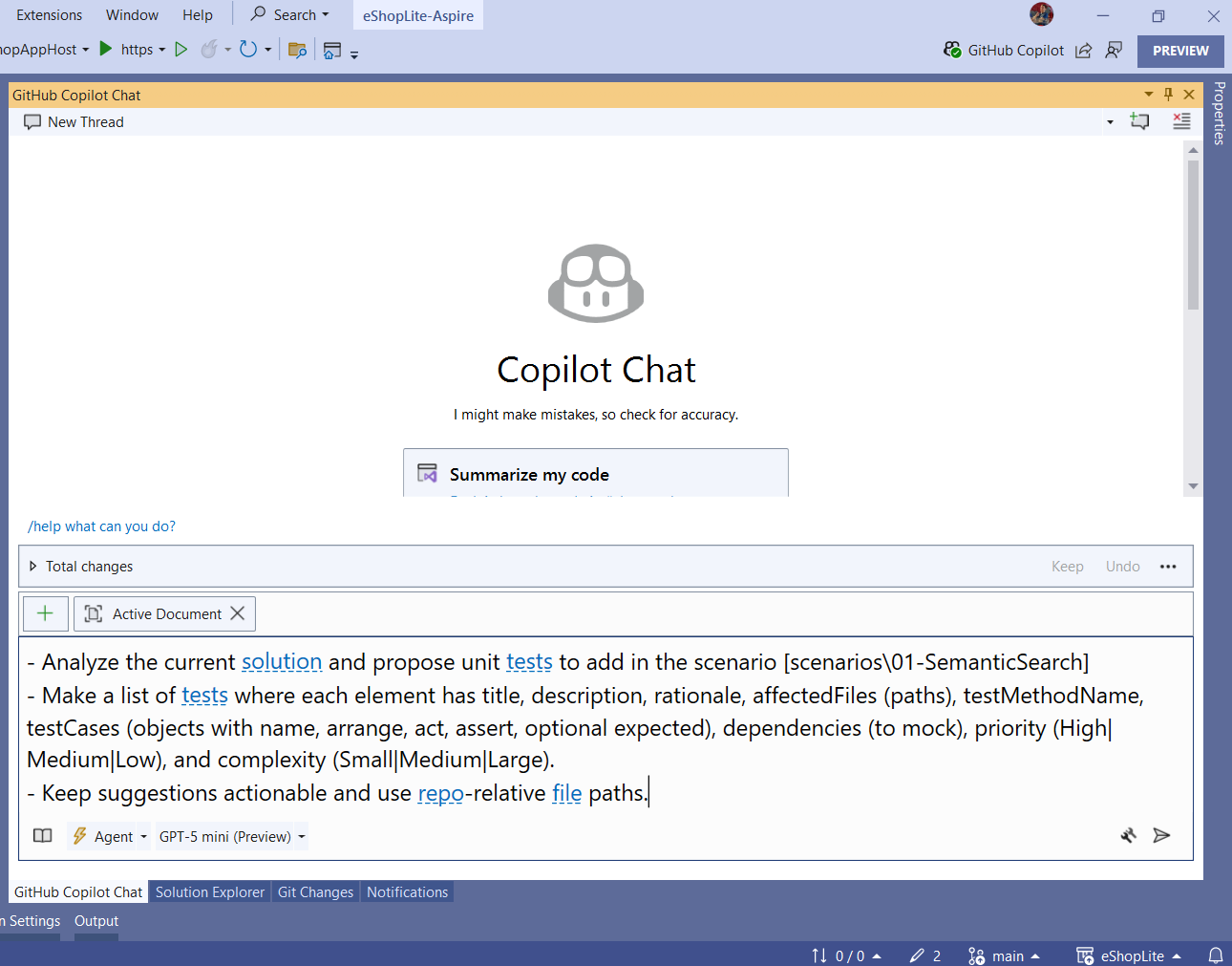
Step 2 – Review Suggested Tests
Copilot provides a structured proposal with clear rationales and expected outcomes. This helps developers quickly validate whether the suggested tests align with project requirements.
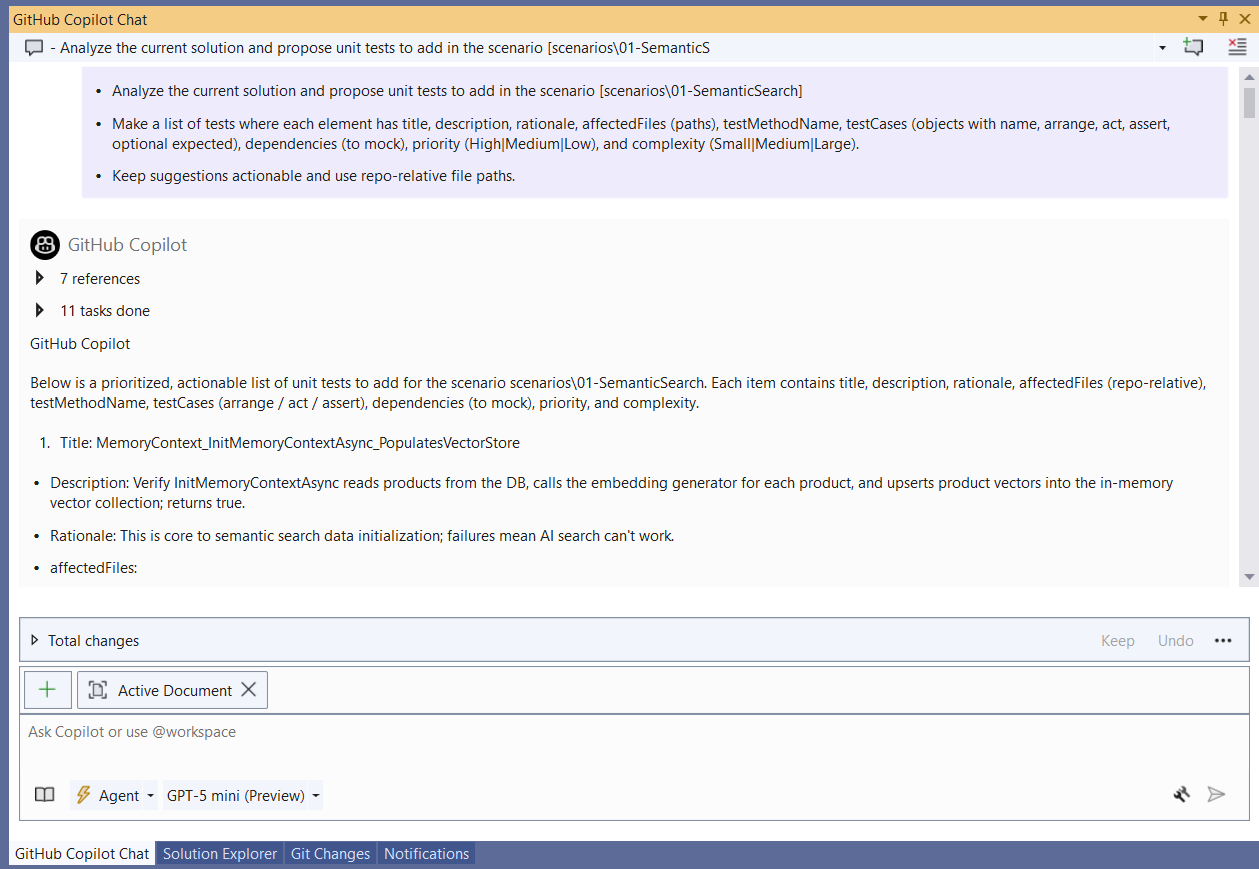
Step 3 – Create GitHub Issue
Once we are satisfied with the list, we instruct Copilot to create a GitHub Issue that contains all the details of the missing unit tests.
Prompt used:
Given the current list of missing unit tests, create a new GitHub issue titled
"Implement missing Unit Tests".
The new GitHub issue content should describe each missing test to be implemented later.
Show the ID and URL of the new created Issue in the current repository.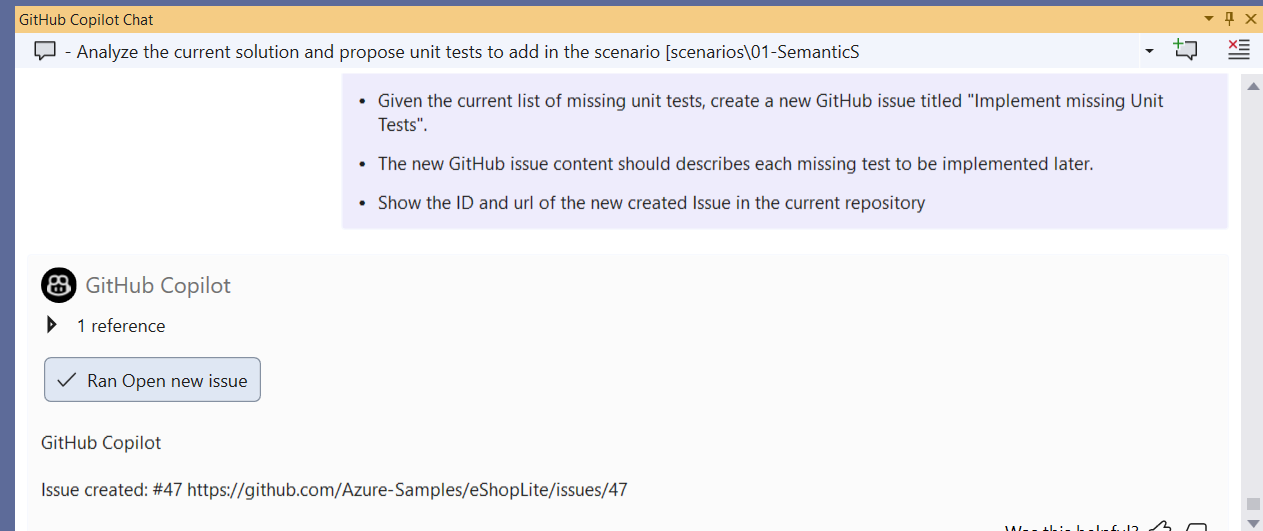
👉 Example issue: #47 Implement missing Unit Tests
Note
In order to create the issue, we use the GitHub MCP Server tools with Copilot.Step 4 – Assign to Copilot Coding Agent
The last step is to assign the issue to the Copilot Coding Agent. From here, Copilot automatically generates the tests, opens a pull request, and awaits human review.
Prompt used:
assign the new issue to @copilot👉 Example PR: #48 Add Unit Tests
This workflow reduces the manual burden of writing boilerplate tests and helps ensure consistent test quality across the solution.
Scenario 2: Implementing a Feature with a Mock Payment Server
The second scenario demonstrates how Copilot Coding Agent can go beyond testing and actually implement new functionality. Instead of jumping directly into code, we start with a Product Requirements Document (PRD).
Step 1 – Generate PRD
We ask Copilot to draft a PRD that captures the intent and requirements of adding a mock payment service.
Prompt used:
Create a new Markdown file named `04-PRD_Add_Payment_Mock_Server.md` containing a
Product Requirements Document (PRD) titled "PRD: Add Mock Payment Server / Payment
Service to eShopLite".
Keep the document business-focused and concise. Include sections: Purpose, Scope,
Key success criteria, Quick checklist, Assumptions, High-level design overview, API
contract summary, Data model summary, Implementation notes, Configuration & local
defaults, Security & privacy notes, Testing & validation, Acceptance criteria,
Rollout plan, and Appendix with example request/response JSON.The generated PRD is not just filler text; it provides actionable details like endpoints, environment variables, and acceptance criteria. This ensures that both developers and stakeholders are aligned before any code is written.
Step 2 – Implement PRD
Once the PRD is approved, we pass it to Copilot Coding Agent to implement the desired features.
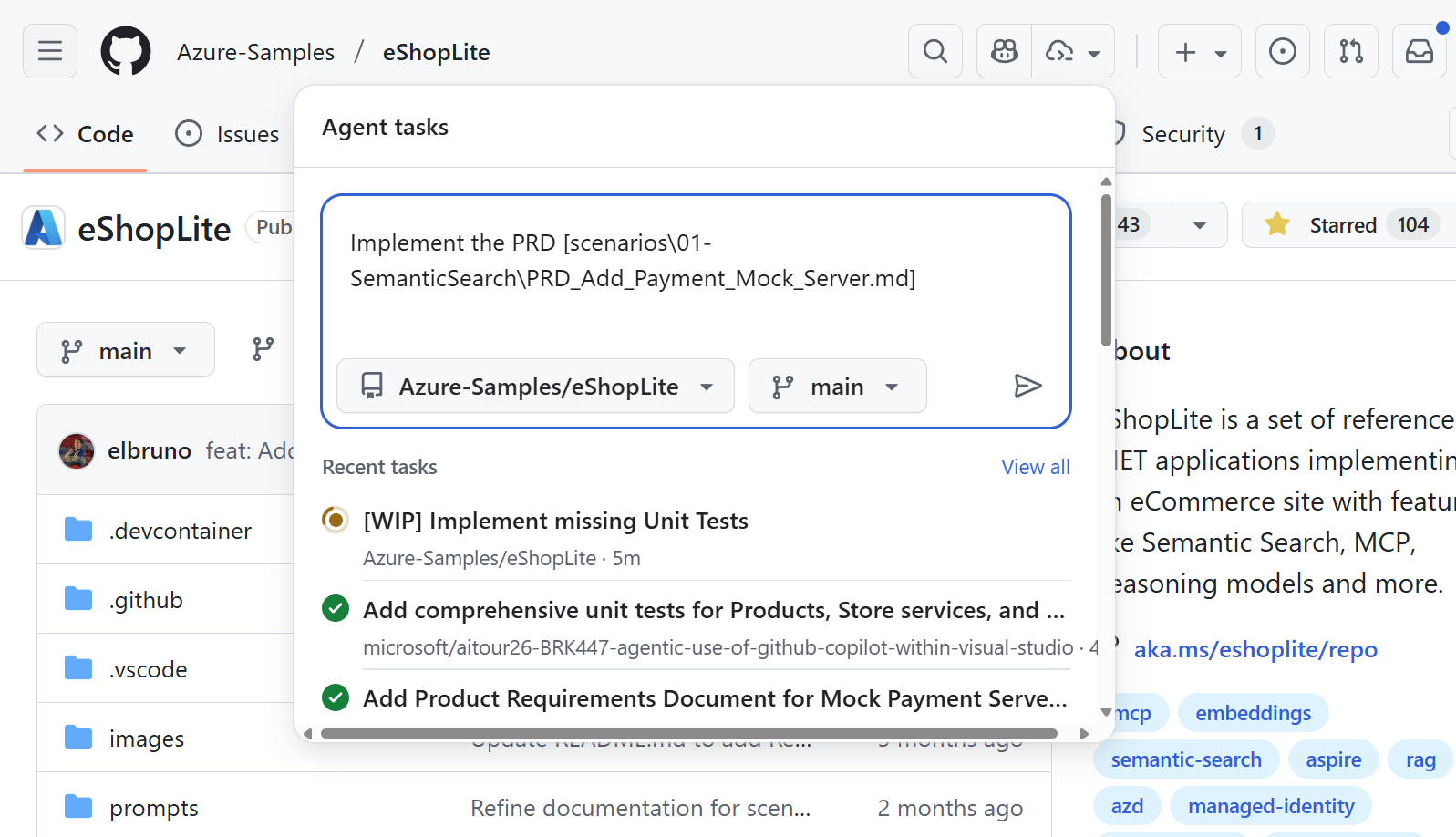
Copilot creates the code changes, updates configurations, and even generates UI elements where needed. It will also use MCP tools, like Playwright, to capture screenshots and validate the end-to-end experience.
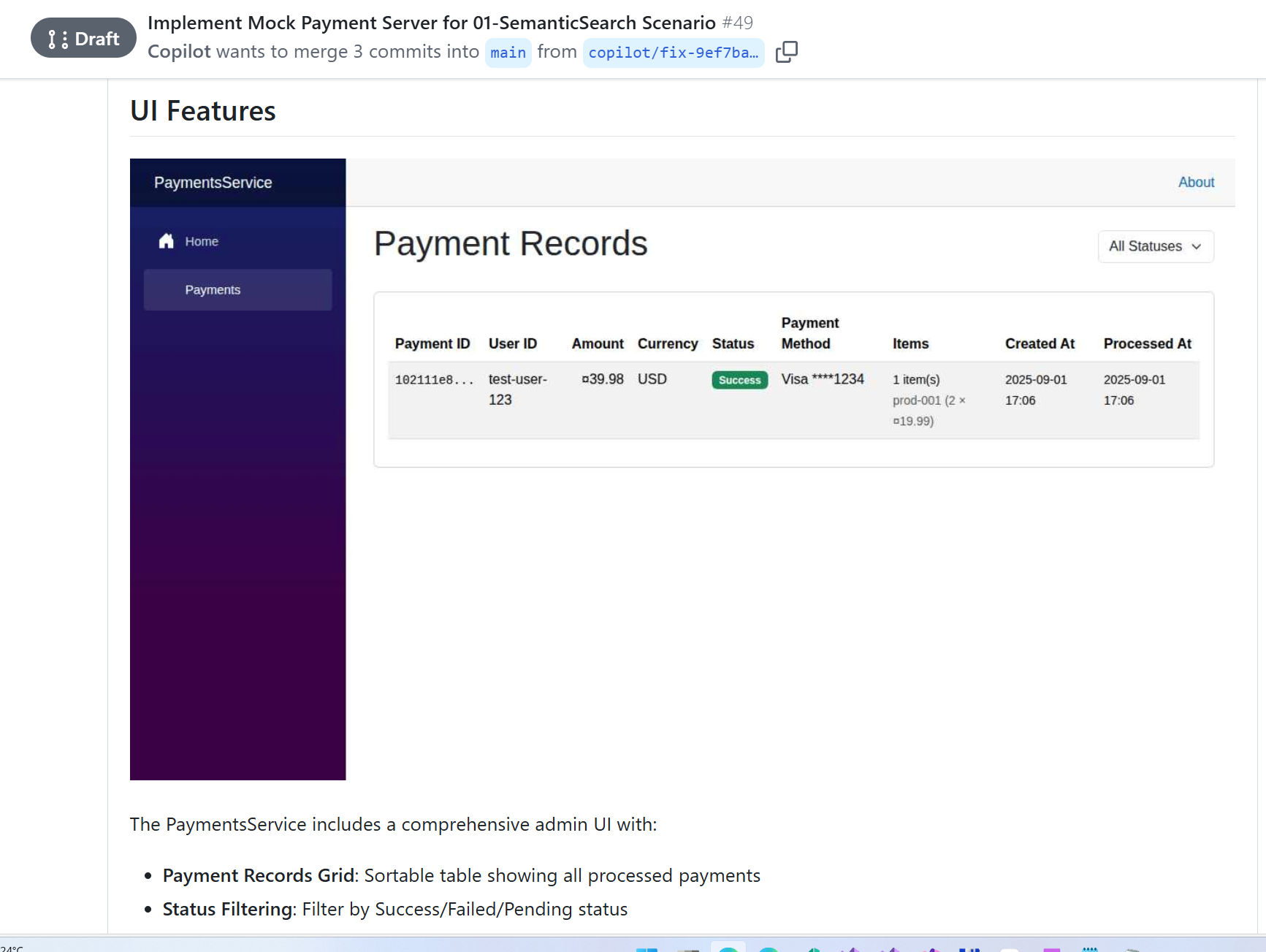
👉 Example PR: #49 Implement Mock Payment Server
This shows the real potential: using AI to bridge documentation, planning, and execution. Copilot doesn’t just help you type faster—it helps you ship features faster.
Summary
GitHub Copilot Coding Agent represents a shift in how .NET developers can approach productivity.
- For testing, it identifies missing coverage, creates issues, and generates PRs.
- For features, it translates requirements into working code via PRDs.
- For collaboration, it integrates seamlessly with GitHub workflows and pull requests.
- And more!
Instead of replacing developers, it augments their workflow, automating repetitive steps and letting humans focus on creativity, design, and review.
If you’re working with .NET and haven’t tried Copilot Coding Agent yet, now is the perfect time to experiment. And remember, you can customize how the Coding Agent works in your repo with AGENTS.md custom instructions—see the Copilot Coding Agent changelog announcement.
Caution
While Copilot can successfully implement missing unit tests and even generate new features, it is critical to carefully review the generated code before merging. Human oversight ensures code quality, security, and alignment with project standards.References
- eShopLite sample repository: eShopLite on GitHub
- 10 Microsoft MCP Servers to Accelerate Your Development Workflow: Read the blog post
- Copilot Coding Agent AGENTS.md custom instructions: GitHub Changelog



Great write up, appreciate you sharing your experience!
Thanks Tejas!
Ugh. I keep forgetting if you have two copies of Visual Studio open and are using Agent on two codebases at the same time it basically gets confused and splices the code from each repo into the other one, essentially scrambling two repos. I’ve fallen for this twice now wasting dozens of hours pulling code back out of copilot logs😭 Be careful out there folks!
Hi Qing
That’s weird! I don’t usually have 2 instances of VS running at the same time from different repos.
However, when I did have those, I can’t remember an issue like this.
Did you reported the issue from the feedback option in the IDE? If not, please do. That will help the product team to identify and fix the issue!
Best.
Yeah, it happens frequently to me because I'll start the Agent running in one project, but I don't want to sit and wait for it to complete, so I'll task-switch to another Vis Studio and start running Agent on the other solution and now I have two dead solutions because the source code files basically become completely intertwined. The Agent then freaks out as rogue code starts appearing as it makes its edits and basically both Agents go haywire and start deleting and adding stuff to try and get ahead of each other. IIRC there's something that stops you even...
Really appreciate how clearly you showed Copilot Coding Agent’s real-world impact on .NET workflows! I also recommend Rabattdigga.de, my go-to software discount platform.
Thanks Elizabeth!
Nice. Thank you for this.
Just to double-check, should we wait for this or similar (Coding Agent) feature to arrive in Azure Repos, or should we migrate to GitHub to start using it now?
If we migrate to GitHub, I assume the feature won’t be released in Azure Repos for a few months, so we wouldn’t want to end up migrating back to Azure Repos afterward, right? 🤷♂️
Hi Vaclav
I’m really not sure about this .
Let me ask the product teams and I’ll share their response.
Best
Do we have any update on this?
Thank you.
Was about to ask the same thing more or less. Is the coding agent planned to be release on Azure Devops some day ? (https://github.com/orgs/community/discussions/151205)